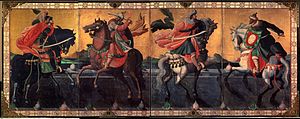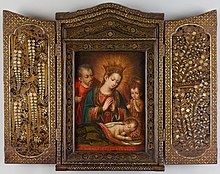258:
246:
234:
52:
68:
218:
31:
270:
182:
or folding screens are particularly notable, with over 90 pairs surviving to this day. These vibrant paintings depicted foreigners of all colors arriving in Japanese ports and walking in the streets of Japanese inland towns
257:
233:
245:
217:
149:, the word took on a new meaning when it came to designate the Portuguese, who first arrived in 1543, and later other Europeans. The term also refers to paintings which Europeans brought to
608:
51:
534:
468:
67:
676:
656:
564:
419:
407:
375:
200:
269:
448:
616:
681:
612:
345:
580:
63:
of c.1611-1614, Kobe City Museum. It is a work that fuses
Western themes and techniques with Japanese techniques.
183:(see figure 1). Another popular subject within Nanban art was the depiction of foreign warriors. Artists of the
128:
639:
199:
and alternative materials and techniques, appear to have had little lasting influence in Japan. Given the
80:
671:
30:
298:
72:
302:
146:
370:
204:
196:
652:
560:
512:
444:
192:
502:
490:
340:
239:
Hasegawa
Nobukata painting of a religious man with children. Edo period, early 17th century.
76:
45:
224:
320:
294:
293:
in the 1850s and the 1860s, there is evidence of earlier
Japanese influence in the art of
530:
184:
142:
41:
647:
665:
263:
Hasegawa
Nobukata painting of two "Western warriors." Edo period, early 17th century.
211:, which largely closed Japan to foreign contact from the 1630s, Nanban art declined.
464:
360:
116:
99:
440:
188:
365:
138:
120:
516:
290:
102:
of the sixteenth and seventeenth centuries influenced by contact with the
17:
380:
328:
286:
170:
124:
59:
36:
507:
491:""Mōko Shūrai Ekotoba" (Illustrated Account of the Mongol Invasions)"
385:
324:
208:
162:
133:
314:
166:
150:
66:
319:. This was derived from the trade in Japanese crafts through the
161:
Nanban art developed after the first
Portuguese ships arrived in
587:
648:
Obras-primas dos biombos Nanban, Japão-Portugal século XVII
251:
Screen painting of foreign ship and
Europeans in Japan.
301:influenced pre-Hispanic lacquerware resulting in
27:Japanese art genre of the 16th and 17th centuries
195:. Canons of western art of the period, such as
535:Japanese Architecture and Art Net Users System
469:Japanese Architecture and Art Net Users System
312:
203:from the end of the sixteenth century and the
175:
108:
91:
306:
223:Painting from Momoyama period (1573-1615) by
8:
403:
401:
289:did not develop in the west until after the
227:of a European woman playing a viola de mano.
75:produced and exported at the request of the
201:persecution and prohibition of Christianity
506:
191:in combining foreign subject matter with
137:, originally referring to the peoples of
430:
428:
275:Namban art, screen painting, circa 1600.
169:and other objects were produced, Nanban
79:. Azuchi–Momoyama period, 16th century,
50:
29:
642:, Chandeigne, 2015 (978-2-36732-121-9)
489:Testa, Giuseppina Aurora (2020-07-03).
397:
213:
335:Museums with collections of Nanban art
7:
376:Japanese words of Portuguese origin
640:Nanban Folding Screen Masterpieces
123:from Europe and specifically from
25:
609:"Biombos Namban (Namban screens)"
268:
256:
244:
232:
216:
557:Namban: Art in Viceregal Mexico
1:
613:Museu Nacional de Arte Antiga
555:Lake, Rodrigo Rivero (2006).
346:Museu Nacional de Arte Antiga
40:of c.1570-1616 attributed to
331:(Mexico) from 1565 to 1815.
187:were joined by those of the
435:Okamoto, Yoshitomo (1972).
313:
193:Japanese styles of painting
698:
581:"Kobe City Museum e-guide"
115:or 'Southern barbarians',
56:Western Kings on Horseback
323:, which traveled between
307:
176:
165:in 1543. While Christian
109:
92:
677:Japan–Portugal relations
645:(pt) Alexandra Curvelo,
638:(en) Alexandra Curvelo,
350:Museu do Oriente, Lisbon
682:History of art in Japan
437:The Namban Art of Japan
83:
81:Kyushu National Museum
64:
48:
70:
54:
33:
651:, Chandeigne, 2015 (
299:Japanese lacquerware
73:Japanese lacquerware
303:Mexican lacquerware
147:Nanban trade period
508:10.5209/eiko.73275
371:Hasekura Tsunenaga
291:reopening of Japan
197:linear perspective
129:Sino-Japanese word
84:
65:
49:
657:978-2-36732-120-2
566:978-84-7506-693-6
327:(Philippines) to
281:Reverse influence
225:Hasegawa Nobukata
16:(Redirected from
689:
629:
628:
626:
624:
615:. Archived from
605:
599:
598:
596:
594:
585:
577:
571:
570:
552:
546:
545:
543:
541:
527:
521:
520:
510:
486:
480:
479:
477:
475:
461:
455:
454:
432:
423:
422:Kobe City Museum
417:
411:
410:Kobe City Museum
405:
341:Kobe City Museum
318:
311:, from Japanese
310:
272:
260:
248:
236:
220:
181:
179:
178:
114:
112:
111:
97:
95:
94:
77:Society of Jesus
46:Kobe City Museum
21:
697:
696:
692:
691:
690:
688:
687:
686:
662:
661:
633:
632:
622:
620:
607:
606:
602:
592:
590:
583:
579:
578:
574:
567:
554:
553:
549:
539:
537:
531:"Nanban-byoubu"
529:
528:
524:
488:
487:
483:
473:
471:
463:
462:
458:
451:
434:
433:
426:
418:
414:
406:
399:
394:
357:
337:
321:Manila Galleons
295:Colonial Mexico
283:
276:
273:
264:
261:
252:
249:
240:
237:
228:
221:
173:
159:
106:
89:
28:
23:
22:
15:
12:
11:
5:
695:
693:
685:
684:
679:
674:
664:
663:
631:
630:
619:on 20 May 2011
600:
572:
565:
547:
522:
481:
456:
449:
424:
412:
396:
395:
393:
390:
389:
388:
383:
378:
373:
368:
363:
356:
353:
352:
351:
348:
343:
336:
333:
282:
279:
278:
277:
274:
267:
265:
262:
255:
253:
250:
243:
241:
238:
231:
229:
222:
215:
158:
155:
145:. During the
143:Southeast Asia
26:
24:
14:
13:
10:
9:
6:
4:
3:
2:
694:
683:
680:
678:
675:
673:
670:
669:
667:
660:
658:
654:
650:
649:
643:
641:
636:
635:bibliography
618:
614:
610:
604:
601:
589:
582:
576:
573:
568:
562:
558:
551:
548:
536:
532:
526:
523:
518:
514:
509:
504:
500:
496:
495:Eikón / Imago
492:
485:
482:
470:
466:
460:
457:
452:
450:0-8348-1008-5
446:
442:
438:
431:
429:
425:
421:
416:
413:
409:
404:
402:
398:
391:
387:
384:
382:
379:
377:
374:
372:
369:
367:
364:
362:
359:
358:
354:
349:
347:
344:
342:
339:
338:
334:
332:
330:
326:
322:
317:
316:
309:
304:
300:
296:
292:
288:
280:
271:
266:
259:
254:
247:
242:
235:
230:
226:
219:
214:
212:
210:
206:
202:
198:
194:
190:
186:
172:
168:
164:
156:
154:
152:
148:
144:
140:
136:
135:
130:
126:
122:
118:
105:
101:
88:
82:
78:
74:
69:
62:
61:
57:
53:
47:
43:
39:
38:
32:
19:
672:Japanese art
646:
644:
637:
634:
621:. Retrieved
617:the original
603:
591:. Retrieved
575:
556:
550:
538:. Retrieved
525:
498:
494:
484:
472:. Retrieved
459:
436:
415:
361:Nanban trade
284:
160:
132:
121:missionaries
103:
100:Japanese art
86:
85:
58:
55:
35:
441:Weatherhill
189:Tosa school
185:Kanō school
42:Kanō Naizen
666:Categories
559:. Turner.
465:"Nanban-e"
392:References
366:Kirishitan
207:policy of
139:South Asia
131:, Chinese
127:. It is a
98:refers to
87:Nanban art
18:Namban art
588:Kobe City
517:2254-8718
501:: 35–57.
623:28 March
593:28 March
540:28 March
474:28 March
381:Yamato-e
355:See also
329:Acapulco
287:Japonism
205:Tokugawa
125:Portugal
420:泰西王侯騎馬図
157:History
117:traders
34:Nanban
655:
563:
515:
447:
386:Nanman
325:Manila
285:While
209:sakoku
163:Kyushu
134:Nánmán
104:Nanban
584:(PDF)
315:makie
308:maque
171:byōbu
167:icons
151:Japan
60:byōbu
37:byōbu
653:ISBN
625:2011
595:2011
561:ISBN
542:2011
513:ISSN
476:2011
445:ISBN
408:南蛮屏風
177:南蛮屏風
141:and
119:and
93:南蛮美術
503:doi
305:or
668::
659:)
611:.
586:.
533:.
511:.
497:.
493:.
467:.
443:.
439:.
427:^
400:^
297:.
153:.
110:南蛮
71:A
44:,
627:.
597:.
569:.
544:.
519:.
505::
499:9
478:.
453:.
180:)
174:(
113:)
107:(
96:)
90:(
20:)
Text is available under the Creative Commons Attribution-ShareAlike License. Additional terms may apply.


